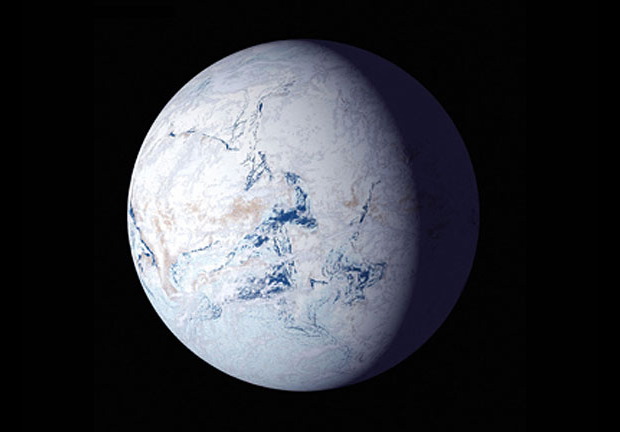Snowball Earth: When the Blue Planet Went White

It's difficult to imagine now, but at certain points in Earth's history, ice covered the entire planet. This frozen Earth, nicknamed snowball Earth, was a setting "so severe, that the Earth's entire surface, from pole to pole, including the oceans, completely froze over," said Melissa Hage, an environmental scientist and assistant professor at Oxford College of Emory University in Georgia.
In 1840, Louis Agassiz, a Swiss natural scientist, was among the first to acknowledge and provide evidence that Earth had gone through ice ages, according to the University of California Museum of Paleontology. Joseph Kirschvink, an American geologist, later coined the term "snowball Earth," in a 1992 textbook. Kirschvink's work was based on evidence provided by Agassiz and others.
Scientists believe that three to four severe ice ages, which froze nearly or all of the surface, occurred between 750 million and 580 million years ago, probably because Earth's land masses were all located at or near the equator, which resulted in increased weathering. Weathering is when wind and precipitation break down rocks and minerals on the planet's surface. The process leads to decreased carbon dioxide levels in the atmosphere, which allows more heat to dissipate from the surface and into space, cooling the planet.
"Increased continental weathering led to a decrease in atmospheric carbon dioxide and [therefore, caused] global cooling," Hage said. "Once the polar oceans began to freeze, more sunlight was reflected off the white surfaces and cooling was amplified."
Typically, ice that forms over the continents, such as ice sheets, will slow weathering and allow atmospheric carbon-dioxide levels and temperatures to rise. However, hundreds of millions of years ago, all of Earth's land masses were located at the equator. Without land masses at the poles for ice sheets to form on, and the weathering and cooling cycle continued unchecked, plunging the planet into a deep freeze, according to Hage.
Scientists estimate that average global temperatures dropped to minus 58 degrees Fahrenheit (minus 50 degrees Celsius) during these ice ages, which each lasted approximately 10 million years. With water unable to evaporate from the ice-covered oceans, the water cycle (in which water travels between the atmosphere, land and oceans) shut down.
There is some debate, however, as to whether the Earth was completely frozen solid or if there were still patches of slushy material or open water at the equator where sunlight could enter the water and allow some organisms to survive. This "slushball Earth" hypothesis was introduced in 2000 by Richard Cowen, an American geologist, according to Dartmouth University.
Get the world’s most fascinating discoveries delivered straight to your inbox.
The intense ice ages eventually melted away. Scientist believe that volcanoes continued to pump carbon dioxide into the atmosphere throughout the ice ages, eventually warming the planet enough that the water cycle could resume.
The increased greenhouse gases (water vapor and carbon dioxide), which retain the heat on the surface of the planet, eventually led to runaway heating, said Hage, raising global average temperatures to 122 F (50 C) over just a few hundred years. This, in turn, led to increased continental weathering, which helped decrease the amount of carbon dioxide in the atmosphere and cool temperatures back down.
A phenomenon known as the Milankovitch cycles also played a part in the ebb and flow of ice ages, according to Hage. The three cycles are named for Mulutin Milanković, a Serbian astronomer, who provided evidence linking climate changes with the changing amount of solar energy the Earth's surface receives based on the planet's position. The cycles refer to slight changes in the shape of Earth's orbit around the sun, the tilt of the planet's axis and how much the Earth wobbles on its axis as it spins.
As the Earth warmed and came out of its deep freeze, a huge explosion of life occurred, known as the Cambrian explosion, according to the University of California Museum of Paleontology. This is the earliest known period within the fossil record in which major groups of animals appear within a very brief geologic time period (about 40 million years).
Will we see another snowball Earth in our future? According to Hage, it's unlikely, due to the spread-out orientation of the continents.
"Even with extreme winters, continental ice sheets would form, which would stop continental weathering and allow carbon dioxide to build up in the atmosphere, leading to warming rather than runaway freezing," she said.
Additional Resources:
- An educational website dedicated to Snowball Earth, created by researchers at Harvard University.
- Did the Snowball Earth Have a Slushball Ocean?
- Read more about the Snowball Earth from Penn State.

Rachel Ross is a science writer and editor focusing on astronomy, Earth science, physical science and math. She holds a Bachelor of Arts in Philosophy from the University of California Davis and a Master's degree in astronomy from James Cook University. She also has a certificate in science writing from Stanford University. Prior to becoming a science writer, Rachel worked at the Las Cumbres Observatory in California, where she specialized in education and outreach, supplemented with science research and telescope operations. While studying for her undergraduate degree, Rachel also taught an introduction to astronomy lab and worked with a research astronomer.


